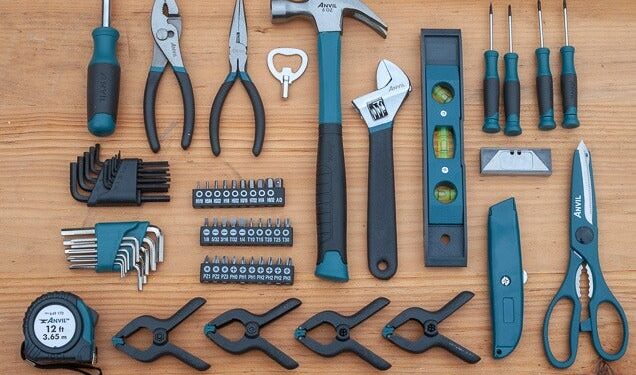Exploring the realm of Beginner toolkits for home repair and upgrades, we delve into the must-have tools and insights for those starting their DIY journey. From understanding the significance of a well-equipped toolkit to how quality tools can be a money-saving investment, this guide covers it all.
Beginner toolkits for home repair and upgrades
Having a well-equipped toolkit is essential for any beginner looking to tackle home repairs and upgrades. It not only helps you complete tasks efficiently but also saves you time and money in the long run.
Essential tools every beginner should have in their toolkit
- A hammer: Useful for various tasks like hanging pictures, assembling furniture, or minor repairs.
- A screwdriver set: Includes both flathead and Phillips head screwdrivers for different types of screws.
- Tape measure: Necessary for accurate measurements when working on DIY projects.
- Pliers: Perfect for gripping, twisting, and cutting wires or small objects.
- An adjustable wrench: Helpful for tightening or loosening nuts and bolts of different sizes.
Importance of having a well-equipped toolkit for home repairs
Having the right tools on hand can make a significant difference in the outcome of your home repair projects. It allows you to work more efficiently, with precision, and reduces the chances of damaging materials or injuring yourself. Additionally, it gives you the confidence to take on various tasks without having to rely on professional help for minor repairs.
Investing in quality tools to save money in the long run
Although quality tools may come with a higher price tag initially, they are a worthwhile investment in the long term. High-quality tools are more durable, perform better, and are less likely to break or wear out quickly. This means you won't have to replace them as often, ultimately saving you money over time.
Must-have power tools for home improvement
When it comes to home repair and upgrades, having the right power tools can make all the difference. Here are some essential power tools every beginner should have in their toolkit.
Cordless Drill
A cordless drill is a versatile tool that can be used for a variety of tasks such as drilling holes, driving screws, and even sanding. It is portable, easy to use, and essential for any DIY project around the house.
Compact Circular Saw
A compact circular saw is perfect for cutting through wood, plastic, or metal with precision. It is lightweight, easy to handle, and ideal for smaller projects like cutting shelves or trimming doors.
Oscillating Multi-Tool
An oscillating multi-tool is a handy device that can sand, cut, scrape, and grind in tight spaces. It is great for detailed work like trimming baseboards, cutting pipes, or removing grout.
Random Orbital Sander
A random orbital sander is essential for smoothing out rough surfaces or refinishing furniture. It provides a swirl-free finish and is perfect for sanding large areas quickly and efficiently.
Corded vs. Cordless Power Tools
When deciding between corded and cordless power tools, it's important to consider the type of project you will be working on. Corded tools are typically more powerful and don't require recharging, making them ideal for heavy-duty tasks. On the other hand, cordless tools offer more freedom of movement and are perfect for smaller projects or areas without easy access to power outlets.
Organizing and storing your toolkit
Keeping your tools organized and properly stored is essential for easy access and prolonging their lifespan. Here are some tips to help you maintain an efficient toolkit:
Proper organization of tools
- Invest in a toolbox or tool chest with compartments to keep tools separated and organized
.
- Label drawers or sections to easily identify where each tool belongs.
- Hang larger tools such as hammers and wrenches on pegboards or hooks for quick access.
Importance of tool maintenance
- Regularly clean and lubricate tools to prevent rust and corrosion.
- Sharpen cutting tools like saws and chisels to maintain their effectiveness.
- Store tools in a dry place to prevent moisture damage.
Creative storage solutions for small spaces
- Utilize wall-mounted shelves or cabinets to save floor space.
- Use magnetic strips or tool racks to hang tools vertically on walls or inside cabinet doors.
- Repurpose old containers or jars to store small parts and accessories.
Safety gear for home projects
When embarking on home repair and upgrade projects, it is crucial to prioritize safety. Having the right safety gear can make a significant difference in preventing accidents and injuries. Here are some essential safety items every DIYer should have in their toolkit:
Essential Safety Gear
- Gloves: Protect your hands from cuts, scrapes, and splinters by wearing sturdy work gloves. Choose gloves made of durable materials that fit well and provide good grip.
- Goggles: Safeguard your eyes from dust, debris, and flying particles with a pair of safety goggles. Look for goggles that are impact-resistant and provide a comfortable fit.
- Masks: Shield your lungs from harmful fumes, dust, and other airborne particles by wearing a respirator mask. Opt for masks that offer proper filtration and a secure seal around your nose and mouth.
Importance of Safety Gear
Wearing safety gear is essential to protect yourself from potential hazards while working on home projects. Gloves can prevent cuts and burns, goggles can prevent eye injuries, and masks can protect you from inhaling dangerous substances. By wearing the appropriate safety gear, you minimize the risk of accidents and ensure a safer working environment.
Choosing the Right Safety Gear
- Assess the type of project: Consider the nature of the project you are undertaking to determine the specific safety gear required. For instance, heavy-duty gloves may be necessary for handling sharp objects, while a respirator mask may be needed for tasks involving chemical fumes.
- Fit and comfort: Ensure that the safety gear fits properly and is comfortable to wear for extended periods. Ill-fitting gear can be a safety hazard in itself, so it's crucial to choose gear that allows you to move freely and comfortably.
- Quality and durability: Invest in high-quality safety gear that meets relevant safety standards and provides adequate protection. Cheap or substandard gear may not offer the level of protection needed for certain projects.
Closing Summary
In conclusion, Beginner toolkits for home repair and upgrades equip you with the essentials to tackle household projects efficiently. Whether it's organizing your toolkit or ensuring safety during projects, embracing these tools and tips sets the foundation for successful home improvements.
Answers to Common Questions
What are the essential tools every beginner should have in their toolkit?
Some essential tools include a hammer, screwdriver set, tape measure, adjustable wrench, and a utility knife.
How can investing in quality tools save money in the long run?
Quality tools are more durable and perform better, reducing the need for frequent replacements and repairs, ultimately saving money over time.
What are some creative storage solutions for small spaces to keep tools accessible?
Utilize wall-mounted racks, pegboards, or magnetic strips to maximize space and keep tools within reach in compact areas.







